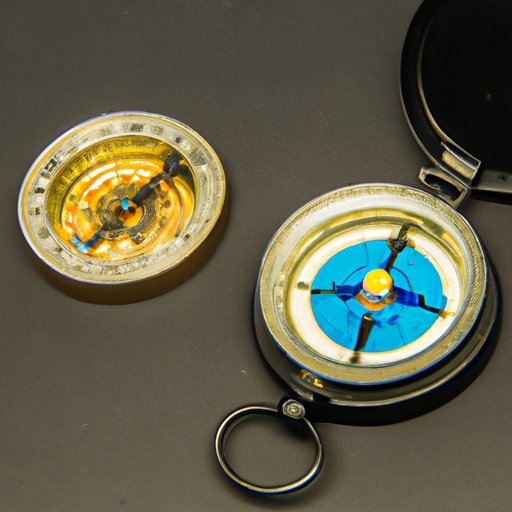Introduction
A compass is a navigational instrument used to determine direction relative to the Earth’s magnetic field. It consists of a magnetized needle mounted on a pivot point, which aligns itself with the Earth’s magnetic field, pointing towards the North Pole. The invention of the compass has had a profound effect on human history, allowing us to explore the world and discover new lands. In this article, we will explore the history of the compass and how it has changed navigation throughout the ages.

Historical Overview of the Invention of the Compass
The earliest known compasses were invented by the Chinese during the Han Dynasty (202 BC-220 AD). According to archaeological evidence, compasses were used for divination and fortune-telling purposes. These early compasses were made from lodestone, a naturally magnetized mineral, and were referred to as “south-pointers” because they pointed towards the south pole of the Earth’s magnetic field. It wasn’t until the 11th century that the magnetic compass was used for navigational purposes.
The early use of the compass for navigation is credited to the Arab geographer Abu al-Fida in 1282. He described a compass as a “magnetic needle floating in water” that could be used to determine directions. By the 14th century, the magnetic compass was widely used by sailors and explorers. It was also used by merchants to calculate the distance between two points.
How the Magnetic Compass Changed Navigation
The magnetic compass revolutionized navigation, allowing sailors to accurately chart their course across the open seas. This enabled them to explore new lands and trade with distant countries. With the compass, sailors were able to travel further and faster than ever before, leading to the Age of Exploration.
The compass also allowed navigators to take advantage of the prevailing winds, currents, and tides, making their voyages more efficient. This enabled them to reach their destinations quicker and with less risk of getting lost. Furthermore, the compass allowed mariners to map out their route and estimate the distance between two points, resulting in better navigation and safer journeys.

The Development and Uses of the Compass Throughout History
Since its invention, the compass has undergone several changes and improvements. Throughout history, different cultures have developed their own versions of the compass, each with its own unique features and capabilities. Here is a brief overview of the development and uses of the compass throughout history:
Ancient Times
The earliest known compasses were invented by the Chinese during the Han Dynasty (202 BC-220 AD). These compasses were made from lodestone and used for divination and fortune-telling purposes. Later, the magnetic compass was adopted by Arab navigators, who used it to chart their course across the open seas. By the 14th century, the magnetic compass was widely used for navigation.
Middle Ages
During the Middle Ages, the compass was further developed and improved. In Europe, the magnetic compass became an essential part of navigation and exploration. Portuguese and Spanish explorers used the compass to chart their voyages to the Americas and other parts of the world. The compass also became popular among merchants, who used it to calculate the distance between two points.
Early Modern Period
In the early modern period, the compass was further refined and improved. The first dry-card compass, which featured a pivoting needle, was invented in 1621. This allowed navigators to take accurate readings without having to worry about the effects of moisture. By the 18th century, compasses were being mass-produced and used by sailors and explorers around the world.
Recent Times
In recent times, the compass has been replaced by more sophisticated navigational instruments such as the Global Positioning System (GPS). However, the compass remains an important navigational tool for hikers and outdoor enthusiasts. Compasses are still used to find one’s location and orientation, and can be combined with GPS units to provide a more accurate reading.
Conclusion
The invention of the compass has had a profound impact on human history. From enabling exploration and discovery to improving navigation and safety, the compass has played an essential role in shaping the world we live in today. Throughout the centuries, the compass has been refined and improved, but its basic function remains the same: to help us find our way.
From its humble beginnings in Ancient China to its current role in modern navigation, the compass has come a long way. Its invention has allowed us to explore the world and discover new lands. As we look to the future, the compass will continue to play an important role in human history.
(Note: Is this article not meeting your expectations? Do you have knowledge or insights to share? Unlock new opportunities and expand your reach by joining our authors team. Click Registration to join us and share your expertise with our readers.)
